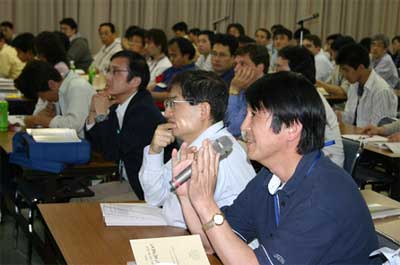| RIKEN Center for
Developmental Biology (CDB) 2-2-3 Minatojima minamimachi, Chuo-ku, Kobe 650-0047, Japan |
| Banana Alligator Garden? Some thoughts on the RIKEN Joint Retreat | |
May 31, 2005 – RIKEN is Japan’s largest publicly funded basic research organization, and its scope spans fields from particle physics to immunology to materials science. On May 9 and 10, RIKEN instituted its first joint retreat, with invited talks and posters by scientists working in four research centers located throughout Japan. The retreat, which was held in the spa town of Atagawa on the Izu peninsula, provided an environment in which researchers from diverse fields could share their findings with RIKEN scientists from other fields of specialty. This first joint retreat focused primarily on life sciences research, with participants from the Brain Science Institute (BSI) and Discovery Research Institute (DRI) in Wako, the Research center for Allergy and Immunology (RCAI) in Yokohama and the CDB. Shinji Masui, a research scientist in the Laboratory for Pluripotent Cell Studies (Hitoshi Niwa, Team Leader) provides a thoughtful reflection on this cross-discipline forum:
The scientific sessions were lively and filled with solid and interesting presentations. For me, the BSI Group Director Takao Hensch’s revelation that Otx2, a gene near and dear to my lab, somehow shows up playing an essential role in a specific type of neuron was eye-opening, as was the talk by Kunihiro Ohta from the DRI, which showed how he was able to produce monoclonal antibodies from the DT40 B-cell line. (I should add that the CDB did itself proud in the presentations as well, but maybe that goes without saying.) The truth is though, I had been expecting and, in fact, eagerly looking forward to, something a bit different. To me at least, the whole purpose of holding a joint retreat at a multi-disciplinary institute like RIKEN is to involve scientists from all labs and all fields of study. I was expecting to see more people working on physics, chemistry and engineering, but there was only a single speaker – Maki Kawai, a surface chemist – working outside the life sciences. I could see she had put a lot into her talk, and her command of English was impressive, but I have to admit I couldn’t understand much of the content. I suppose the audience and the speakers were equally at fault. As scientists, when we sit in on a talk by a speaker from a completely different field, we’re not there to hear an itemized list of all the little technical details that led up to some finding, what interests us is the process that led to a breakthrough in that field (and that includes not just the philosophical underpinnings and the methodological rationale, but the relevant aspects of day-to-day work in the lab, even administrative concerns, as well). that seems to be the only possible way for specialists in widely divergent fields of endeavor to even have a hope of making meaningful contact. That means that speakers preparing a talk for such an audience need to structure it such that they get to the point right at the beginning of the talk, and then take the audience on a tour in which they unravel and explicate the processes that led them to their discovery. Of course, this whole caveat may only apply to relatively young scientists. The audience, for their part, have to ready themselves to extract the real essence, the inspiring sense of progress, when they listen to reports from other fields. I don’t mean this account to discourage more interaction between labs in all fields of science. Masatoshi Okouchi, one of RIKEN’s most eminent scientists and leaders, described the “RIKEN spirit” as a release from conventions and constraints, saying, “Physicists should be free to try their hand at chemistry, and chemists free to do physics.” Of course, there are administrators who would say that today’s competitive environment instills and even enforces creativity and novelty (and perhaps even the majority of researchers today would agree), and that a structured setting and the disciplined adherence to a routine by true “professionals” is the most efficient approach and the surest route to a successful scientific career. But it’s also important to keep in mind (or should I say “realize”?) that those same professionals who have forsaken the true pursuit of science and are busily churning out publications are a sorry lot, bound and coddled by convention and neither willing nor able to go beyond those comforting, familiar and clearly marked confines. And not a few of us are among their number. It is precisely those attempts to go beyond established knowledge and ways of thinking about the world that will help to make RIKEN the “paradise for scientists’ it was established to be, and in a larger sense, each such experiment is a step leading to the revolutionary science described years ago by Thomas Kuhn. Only by exercising their ability do the able make a contribution. If nothing else, the Atagawa Heights fulfilled its role in providing the sense of freedom and release from the everyday that let us entertain ideas like these. Perhaps it did that a little too well….
|
|
[ Contact ] Douglas Sipp : sipp@cdb.riken.jp TEL : +81-78-306-3043 RIKEN CDB, Office for Science Communications and International Affairs |
| Copyright (C) CENTER FOR DEVELOPMENTAL BIOLOGY All rights reserved. |
